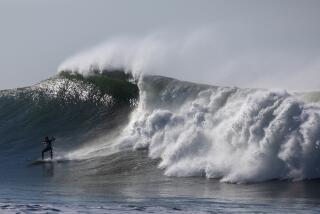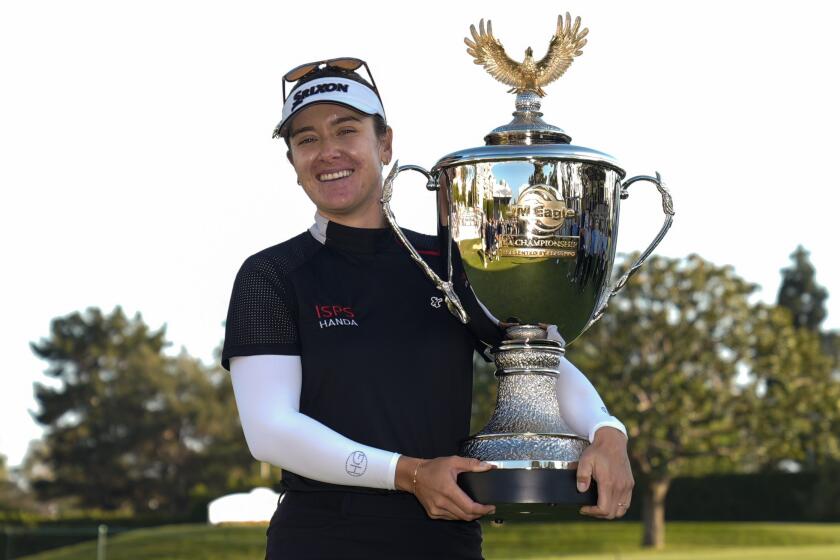Surfer Kelly Slater’s wave of success is as big as ever
At the Florida shorebreak, the boy surveyed the Atlantic Ocean as it punched land.
He calculated the sizes and shapes of the undulating waves, analyzed the angles and directions as they arrived and deciphered what he believed was a language meant just for him.
“I felt like I was interacting with the waves,” Kelly Slater says, “and they were interacting with me.”
PHOTOS: Nike U.S. Open of Surfing
About a decade later, the 15-year-old danced with the Pacific Ocean off Hawaii, and other surfers saw how he read the water in ways they could not, as if he were plugged into its energy and had uncovered secret rhythms.
“He had a connection with the way the ocean moved that was light-years beyond his peers,” says Chris Malloy, Slater’s longtime friend.
Now 40, Slater is still beyond his peers and his legend has moved to the discussion of “Greatest Athlete Ever.” Crunching the numbers, it’s an argument that holds water.
“If nothing else, it’s an interesting debate,” Slater says, shrugging.
It is not just that the Cocoa Beach, Fla., native has a record 49 Assn. of Surfing Professionals Elite Tour wins — he’s shooting for No. 50 this week at the Nike U.S. Open of Surfing in Huntington Beach — or that he has 11 world titles while the next closest in surfing, Mark Richards, has four.
It’s something beyond wins and titles. It is time.
Slater has been the Everest of his sport for most of two decades. No athlete — not Jordan, Gretzky, Ali, Pele, Nicklaus, Tiger, not Phelps — has been that dominant for so long.
Slater is the youngest surfer to win a world title — at 20, in 1992 — and the oldest — 39, achieved last year. This year, he stands No. 2 on the ASP World Tour behind Mick Fanning, with title No. 12 within reach.
Slater says he’s not concerned with legacy, and that unconquered goals are not what’s standing between him and retirement. Though notoriously competitive, Slater says he’s more calm and at peace than ever, that he’s not as attached to the outcome as he was years ago.
Instead, he’s just out there in the blue, sculpting waves into works of art in a place that helped rescue him whenever his world crumbled to pieces.
::
“The water was his security blanket. That was where he felt safe.”
Slater’s mother, Judy
Slater’s father, Steve, owned a bait-and-tackle shop, worked in construction and was an unpredictable alcoholic. “He wasn’t violent or mean in any way,” Judy says. “He was just scary.”
In his autobiography, “Pipe Dreams,” Slater wrote that his mother would scream at his father for hours until he’d finally pass out. The two divorced when Slater was 11, and he found solace in the sea.
“He could just unload his problems in the water,” Judy says.
Those days seem distant for Slater, who owns houses in Hawaii, California, Florida and Australia, has been valued at about $20 million, and dated Pamela Anderson and Gisele Bundchen. But he spent much of his childhood in poverty.
His mother worked as a bartender, waitress, maid, firefighter and emergency medical technician, and cleaned construction sites to make ends meet. At night, she cashed in coins for dollar bills so that her three sons — Stephen, Kelly and Sean, the oldest — felt more secure when she gave them money.
“It was hard when we were younger,” Sean says. “We didn’t know it, but it was.”
Slater yearned for stability in his personal life. The sport helped, providing him surfing “families” in hot spots across the globe. Slater needed a way to channel his anger and the sport helped with that too.
For example, after an appearance on “Baywatch,” Slater heard snarky comments from other surfers. So he narrowed his piercing jade eyes and crushed them in competition.
“It felt like I really had something to prove for a long time,” he says.
Slater used slights — real or manufactured — as his fuel and would concoct scenarios in which he cast himself as the underdog, or a man with everything to lose, even as he collected world titles in succession.
If someone close to him died, as his father did in 2002, Slater vowed to win his next contest in that person’s honor. Everything was motivation.
Slater was in his prime, having won five consecutive world titles, when he retired in 1998, citing boredom and burnout. He stayed away from full-time competition until 2003, returning reenergized and with a new maturity.
During Slater’s break, Andy Irons, the only surfer to challenge Slater’s place as the sport’s king, won two of his three world titles. But their rivalry didn’t last and Slater reclaimed his throne.
Four days after Irons died in 2010, Slater won his 10th world title and dedicated it to him.
::
“Kelly always made it look so effortless. He was walking on water while others were sort of hiking.”
Mark Cunningham, legendary bodysurfer
The ocean’s machinations are ever-changing, forcing surfers to adapt wave to wave. In the same way, Slater is constantly transforming himself.
Fellow surfing pro Owen Wright calls him a “chameleon.”
Slater has said he doesn’t drink, smoke or take drugs, and over time he has adjusted his diet, tweaked his surfing style and redesigned his board to the eighth of an inch in his quest for perfection.
“He’s surfing better than he ever has,” says Evan Slater (no relation), the vice president of marketing for Hurley and a former editor of Surfing Magazine.
Even after a win, Slater is known to celebrate only briefly before he checks surf reports looking for other nearby swells to conquer.
“I think the reason he became so good at what he’s done — and I don’t mean this in a bad way — is everything else in his life came second,” says Brett Simpson, an ASP tour surfer.
Slater is surfing’s most noted ambassador since Duke Paoa Kahanamoku, who was known as “The Father” of surfing and was largely responsible for introducing the sport to California and Australia.
During his reign from the 1990s to the present, Slater helped the sport achieve new heights, with surf companies worldwide growing 20 to 30%, says Robert McKnight, chief executive of Quiksilver, the world’s largest surf-wear company.
There’s no way Judy could have predicted all this for her son, but she says she knew he was special in the water when he could pull off 360-degree turns on a boogie board at age 5, and when he won his first surf contest at 8. Watching him surf, she says, is like watching a symphony.
::
“Maybe the fear of death is really the fear that we haven’t achieved the things we wanted to do in life …”
Slater, from his book, “Kelly Slater: For the Love”
Friends say Slater has a calm about him now, a drastic shift from his high-strung mind-set of two decades ago. His friend Malloy guesses it’s because Slater now realizes that his achievements will not be matched.
“I just know that any contest isn’t going to make or break me,” Slater says, explaining his newfound peace. “If I win, it just sort of adds to the enjoyment for me. If I lose, I don’t think everyone is going to judge me for it.”
Young talent — 19-year-old John John Florence is pegged as the next big thing — keeps Slater sharp, but he says he’s not waiting for anyone to put him out to pasture. When he does retire, there are projects to keep him busy — a surfing film he’s thinking about making, a large-scale wave machine he’s working to build.
His surfing career is essentially year to year, as it has been for some time.
Malloy notes that for several years, Slater waffled over whether he’d even compete on tour, leaving other surfers to believe that, maybe, just maybe, they’d finally have a chance at a world title.
Then he’d show up to the first event, disappointing them, satisfying himself. A force as steady as the waves, reliably rolling in, time and again.
twitter.com/BaxterHolmes
More to Read
Get our high school sports newsletter
Prep Rally is devoted to the SoCal high school sports experience, bringing you scores, stories and a behind-the-scenes look at what makes prep sports so popular.
You may occasionally receive promotional content from the Los Angeles Times.






